Business selling is a concept that’s been around for almost as long as commerce. Bartering was the earliest form of selling – the trading resources between people from different groups. From there, the idea of sales has developed into a skill that’s almost a science. Social selling is just one element of that skill.

When we think about the term social selling, we immediately think of social media platforms, analytics, and lead generation. However, in reality, the social aspect of selling has always been at the core of trade.
Building relationships with customers has always been essential. Whether we think about the bartering example or the modern social media one, sales has always relied on connection and trust. Establishing these core principles is easier said than done, but they’re crucial parts of the skill of social selling.
Our modern idea of social selling is often something that B2B companies make use of the most. However, B2C and C2C industries have used similar techniques for many generations. So what does this term mean for us now? And how is it utilized across the major social media platforms? We take a detailed look at the history of social selling, and what the future may hold.
Social Selling and How it Changed Traditional Selling
Let’s start by looking at a modern idea of what social selling is. It’s still very much about building relationships, fostering trust, and reaching out to potential customers. But the internet has made that process a much different one than it was 20 or 30 years ago.
At a Glance
Nowadays, social selling is a crucial part of the marketing process. According to LinkedIn, social sellers attract 45% more opportunities than their peers. They’re also 51% more likely to achieve their quotas, and they outsell their non-social counterparts 78% of the time.
Other stats paint a similar picture, with one study showing that sales teams who use social as part of their sales process experience 18% more pipeline (volume) 28% faster (velocity).
With these remarkable stats in mind, it’s little surprise that 90% of the top sales people use social selling tools. After all, 67% of the customer journey now takes place online, so the opportunities are there.
Pre-internet Sales

Traditional selling often used to mean picking up the phone and contacting local businesses to pitch your product or services. Sales reps would spend their days cold calling potential leads to try and drum up business. It was often a thankless task, ruled as much by luck as judgment.
Another popular method of direct marketing was to send correspondence by post. Mailing out flyers was again a fairly scattershot approach that took time and resources.
Of course, contacting leads by phone and mail are still viable sales methods. It’s just that the internet has changed everything else. You’re no longer limited to simply flipping through the business directory, looking for potential leads.
The Internet Changes Everything
Although email has technically been around since the late 70s, it was only after the introduction of the internet in 1991 that it started gaining popularity. By the end of that decade, more and more marketers were joining the email revolution.
Of course, it was a little like the Wild West at first. Companies could email whoever they wanted. It wasn’t until the late 90s and early 2000s that anti-spam and opt-out laws were introduced.
In the 26 years since the first internet sales transaction (a CD purchased in 1994), the internet has transformed the way we think about sales and selling. And the change of pace only seems to be accelerating.
It was in 2006 that the term ‘sales 2.0’ was coined after research by the University of British Columbia looked at the relationship between buyer and seller. They found that, when there are similarities between the two, a sale is more likely to take place.
This discovery came at the same time as online social connections were gaining popularity. As such, Nigel Edelshain was the first to put the science into practice. He named it sales 2.0, after the rise of web 2.0. However, it soon became known as social selling.
We now have detailed analytics on customer habits, new ways to engage with potential customers, and powerful tools that help us predict trends. The more social we’ve become online, the more our ways of selling have to change.
Major Social Channels and Social Selling
The first website we’d recognize as a social media site launched all the way back in 1997. SixDegrees allowed users to create a profile, upload a picture, and create social webs of people they knew and were related to.
SixDegrees followed the social media format that many of us are familiar with today. It was soon followed by Friendster in 2002, LinkedIn and Myspace in 2003, Facebook in 2004, Twitter in 2006, and Pinterest and Instagram in 2010. So, in effect, today’s biggest names in terms of social selling launched over a period of seven years.
At a similar time as social media platforms were emerging, advances in CRM technologies were also kicking off. Siebel Systems had launched in 1993, but it wasn’t until 1997 it, and other CRM systems, became commonplace. Salesforce and Oracle also gained popularity, and in 2004, SugarCRM launched.
These CRM systems gave sales teams a much greater insight into how their customers behaved. They would also serve as the basis for social analytics. Combined, these technologies give sales people the ability to find new leads.
In the 17 years since the launch of social media as we know it, each platform has evolved, improved, and refined its approach. There have been scandals and missteps along the way, but each now presents a unique opportunity for businesses to market themselves.
Let’s take a look at how each of the major platforms has progressed over the years in terms of social selling:
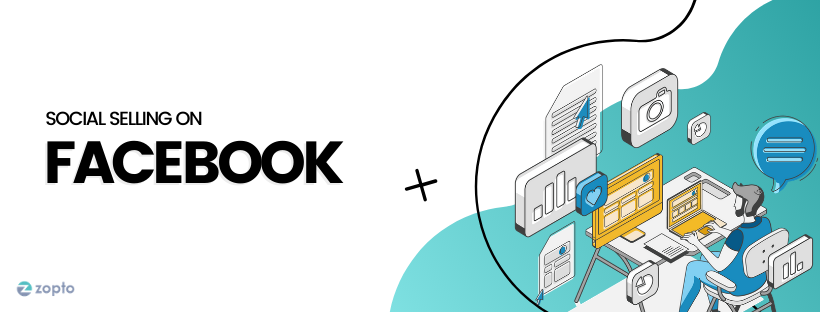
Facebook is perhaps the name most associated with social media. It’s the platform that grabbed the attention of the world shortly after its launch in 2004. By 2007, it was estimated that Facebook was worth $15 billion after Microsoft purchased a 1.6% share.
It was also in 2007 that the platform launched Facebook Pages. This game brands the chance to start building relationships with their customers in an entirely new way. Liking a brand page gave consumers the chance to declare their interest in that brand. This made having a presence on the platform a must-have for business across the world.
In 2009, Facebook revamped and expanded the option to run promotions and contests. Again, this gave companies the chance to grow their fan bases. When a person interacted with a promotion or contest, everyone in their network would see that interaction. Again, this demonstrated the value of social selling on Facebook.
By 2010, the platform had launched storefronts that businesses could use to sell directly on the platform. Facebook commerce was seen as a viable revenue stream, as well as allowing people to share and expand their networks.
2012 saw the addition of ‘Featured Posts’ in news feeds. These sponsored advertisements gave companies a way to reach new people on social networks. That year also saw the switch to timelines for business pages. This gave brands the chance to tell their stories, cultivate content, and develop an ongoing narrative.
Now, Facebook gives businesses the chance to cultivate high-quality content that’s relevant to their customers and potential leads. There are also Groups, which allow you to connect with potential leads and foster a relationship.
The history of social selling on Facebook is long and varied, and still very much a work in progress. Despite its huge potential, brands are still figuring the best ways to approach it.
People of Note
So, who are some of the people that have made this platform so successful for social selling? Well, there are a number of thought leaders and influencers behind this success:
- Mari Smith. Known as the ‘Queen of Facebook’, Smith is a marketing expert and a widely recognized social media thought leader. She’s one of the most knowledgeable people in the world when it comes to Facebook. She famously said, ‘The secret to social media success is to think and act like a member first, and a marketer second.’
- Andrea Vahl. Andrea co-wrote Facebook Marketing All-in-One for Dummies and is an expert in the field. She is a consultant and speaker who has been on the platform from basically the time it started.
- Larry Kim. Larry Kim has been named search marketer of the year three times. His breadth of knowledge has helped shape the way we understand the platform today. On social marketing, he said, ‘Why would you create something if not to promote it.’
- Rachel Pedersen. As one of the thought leaders of Facebook social selling, Rachel has run millions of ads on the platform and knows about every aspect of Facebook marketing.
- Jon Loomer. Jon is a business consultant, Facebook marketing coach, and strategist. He provides a wide range of free content related to social selling.
- Amy Porterfield. Forbes named Amy as one of the Top 50 Social Media Power Influencers. She teaches all kinds of social marketing strategies. On Facebook, she’s quoted as saying, ‘Facebook is your leads generator, not your sales generator.’
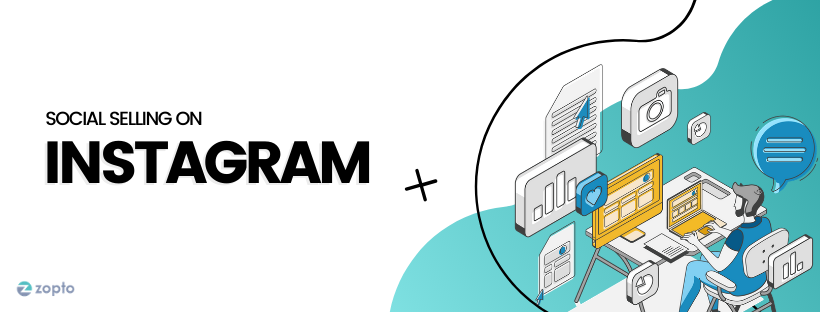
Instagram is the platform of the influencer. For many, it doesn’t seem like an obvious choice for B2B marketing. However, 33% of B2B companies are now on Instagram. It’s also a platform with a very high engagement rate.
Although a relative newcomer to the social media and social selling space, Instagram has grown quickly. After its 2010 launch, it was purchased by Facebook for $1 billion in 2012. By 2013, it had 100 million monthly active users.
However, it wasn’t until 2014 that it really became a viable platform for businesses. This was the year they released a suite of business tools, giving analytics and insight into how customers engaged with brand pages.
By 2015, the platform allowed 30-second adverts for advertisers. In 2016, businesses received access to further tools for marketing. With analytics on demographics, impressions, and reach, the platform was soon becoming an important place for social selling.
In 2020, Instagram statistics show that 90% of accounts follow at least one business on the platform. It’s seen by consumers and businesses as an effective platform to market on. Of course, influencers still play a major role in this. Collaboration between brands and influencers is becoming increasingly popular.
Instagram Stories give brands the chance to experiment with new and creative ways of advertising. Whether it’s creative calls-to-action or tailored offers and promotions, there’s huge potential for social selling.
People of Note
When it comes to the noteworthy people in the world of Instagram, there are a few names that immediately jump out:
- Sue B. Zimmerman. Known as ‘theInstagramExpert’, Sue’s blog ranked as one of the top 10 social media blogs in 2017. In the same near, the Huffington Post named her as one of the Top 50 Must-Follow Women Entrepreneurs. She’s also one of the most popular CreativeLive instructors. Her approach to marketing is summed up with this quote, ‘Be hyper-focused on your market niche so you can stand out and give value.’
- Elise Darma. As an all-round social media guru, Elise promises to help business owners save time and make sales. She’s appeared on all kinds of blogs and podcasts.

- Melanie Aubert. As a marketing coach and sales expert, Melanie runs an online marketing academy. She helps people grow their business and social media presence.

- Jenn Herman. Jenn is an Instagram expert, blogger, speaker, and consultant. She’s highly influential in the world of social media marketing. In her opinion, ‘You should put the time and effort into really knowing what your answers are if you’re going to create a social media strategy that will actually see results.’

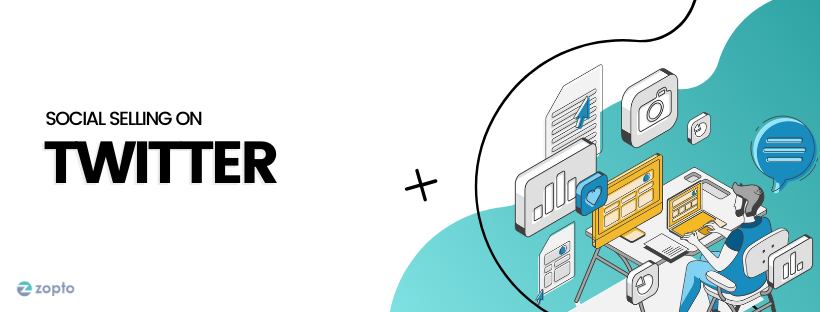
Twitter is the home of the hashtag. The microblogging and social networking site launched back in 2006 and is now one of the most popular platforms around. With 330 million monthly active users and 500 million tweets sent per day, it’s an ideal place for businesses to engage with their customers.
Today, it’s estimated that around 85% of small and medium businesses provide customer service through the platform. It’s a place where content can go viral almost instantly, and businesses strive to have their hashtag trend.
However, it was only in 2010 that the platform started allowing advertising and promoted tweets. Despite that, businesses have long-held accounts on the platform. Given the rapid-fire and short-form nature of Twitter, it can be a challenging but rewarding place for social selling.
Of course, it’s also somewhere that requires a lot of attention and insight. That’s why the company has added various tools for businesses over the years. Twitter Amplify launched in 2015 to give publishers and creators monetize their video content. That year also saw the unveiling of promoted videos, giving companies the chance to expand their reach.
Nowadays, the Twitter widget and embed feature are staples of content marketing.By giving your customers and potential customers the chance to see and share the content you make, they’re helping you target that content to the relevant people.
People of Note
There are plenty of notable people on Twitter when it comes to social selling. Whether it’s influencers or thought leaders, it’s one of the popular marketing platforms:
- Lori Richardson. Lori is a B2B sales influence and assessment strategist. She tweets about all things related to social selling. As she terms it, ‘selling is really about having conversations with people and helping improve their company or their life.’
- Trish Bertuzzi. As a social media prospecting expert, Trish has a detailed knowledge of sales development and social selling in general.
- Nancy Nardin. Nancy produces a wide variety of free content and training related to sales tech. LinkedIn named here a top sales influencer for 2019 and 2020.
- Dan Knowlton. As one of Twitter’s social selling thought leaders, Dan was named as a Top 100 Digital Marketing Influencer. His mantra is, ‘it’s not what you know, it’s how quickly you can learn.’
- Ted Rubin. Ted is a leading Social Marketing Strategist, as well as CMO of Photofy. He’s best known for his theory on ‘Return on Relationship’.
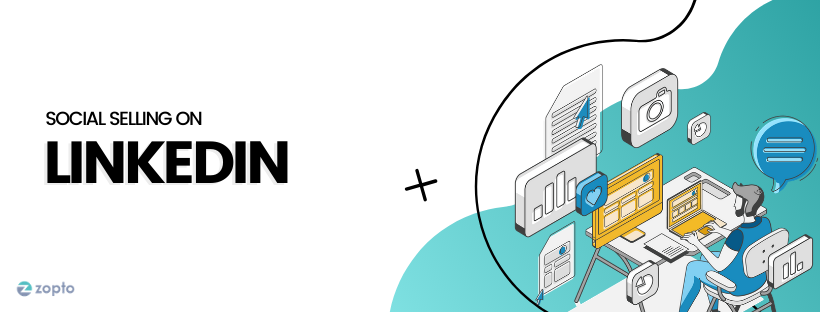
Despite being one of the oldest social media platforms on our list, LinkedIn took a while to gain traction from a social selling point of view. The professional network platform has been around since 2003 but didn’t reach the 10 million user mark until 2007.
2005 saw the company launch both LinkedIn for Groups and premium Business Accounts. Both of these gave companies and recruiters the chance to analyze and search in greater depth. In 2008, the company launched targeted advertising.
By 2012, the company launched its own influencer program. This allowed ‘thought leaders’, selected members of the LinkedIn team, to curate and share content with users. The following year, companies and users could pay LinkedIn to sponsor their content.
Their acquisition of Lynda.com in 2015 saw LinkedIn move into the eLearning sector, something that persists until this day under the LinkedIn Learning feature. This is a valuable tool for content creators of all kinds.
Perhaps the most significant step in this context was the launch of LinkedIn’s Sales Navigator tool, unveiled in 2014. It gives B2B organizations the opportunity to manage their sales funnel via the platform. You can check out our LinkedIn lead strategy for some top tips on how to make the most of this tool.
The Sales Navigator has continued to grow and evolve over the last few years, making social selling an easier and more insightful process. Sales professionals now get actionable alerts on their homepage, making the platform one of the best for social selling.
Part of the reason for LinkedIn’s recent success in this field is that the platform provides a variety of ways for sales teams to connect with potential leads. You can deliver something of genuine worth, reach out to people who will find your services useful, and build strong relationships. This makes things much easier when you reach out to your ideal prospects.
People of Note
LinkedIn has many influential people when it comes to social selling. It’s what makes the platform one of the best for this kind of marketing. Here are some of the main figures:
- Neil Patel. As one of the best-known web marketing gurus around, Neil is an expert in just about every area of social selling. On the importance of the practice, he says, ‘If you are looking for a way to grow your business’s brand without spending a lot of time, I recommend that you start with social media sites like Twitter and Facebook.’
- Daniel Disney. As his LinkedIn banner explains, Daniel is the ‘king of LinkedIn & social selling’. He’s also the number one most influential sales expert on LinkedIn 2019 & 2020.
- Ted Prodromou. Ted is a business coach and LinkedIn marketing expert. He helps businesses find their ideal sales strategies for the platform.

Tim Hughes. Tim Hughes is universally recognised as the world leading pioneer and exponents of Social Selling and he is currently ranked Number 1 by Onalytica as the most influential social selling person in the world. He is also Co-Founder and CEO of DLA Ignite and co-author of the bestselling books “Social Selling – Techniques to Influence Buyers and Changemakers” and “Smarketing – How To Achieve Competitive Advantage through blended Sales and Marketing”. Both published by Kogan Page.
DLA Ignite | Facebook | Instagram | Twitter | LinkedIn | YouTube
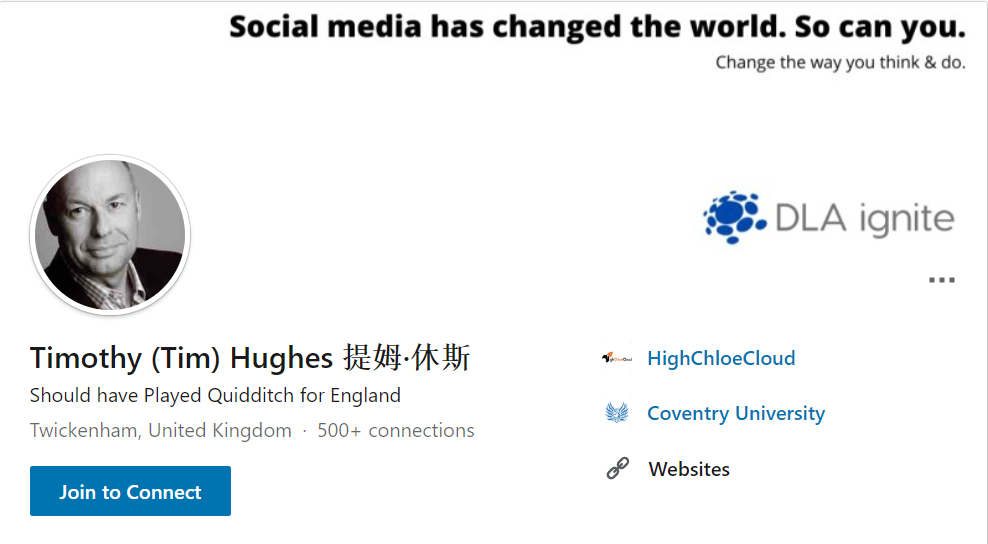
- Neal Schaffer. Neal is another all-rounder with his knowledge of social media. He helps companies around the world with their sales and marketing and even teaches digital media at university level. On utilising social for sales, he said, ‘If you’re not regularly experimenting with your social media efforts, you’re not maximizing your social’

- Koka Sexton. As one of the most recognized marketing experts in the tech industry, Koka helps B2B companies grow revenue online.
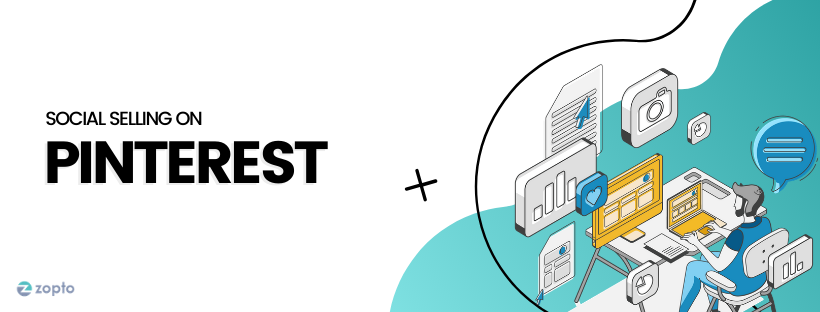
Pinterest is another relative newcomer to the table, launching in 2010. The image sharing and social media platform gives users the chance to discover and share photos, videos, GIFs, and collections of those elements.
By 2012, the service had grown in popularity, with several high-profile figures using Pinterest. It was also the year that they added automatic author attribution for images from certain high-authority sites.
2012 was also a significant year for social selling on the platform. It was in October of that year that business accounts were launched. These allowed brands to have a more authentic presence on the site.
In 2014, there were more than 30 billion pins on the platform. As such, the Guided Search for mobile was introduced. This made it easier for users and businesses to make sure their content was found. Later that year, advertising was launched via promoted pins, as well as more detailed business analytics.
2015 was another game-changing year for social selling. Pinterest launched its Marketing Developer Partners program, allowing marketers to have a more organized approach to their activity.
The next milestone came the following year when Pinterest launched videos and sponsored videos to the platform. In 2017, search advertising was launched, allowing marketers to run search ad campaigns.
People of Note
Despite being a relatively new platform, there are still plenty of big names and influencers when it comes to marketing on Pinterest. Here’s just a small selection:
- Anna Bennett. Vancouver-based Anna is a Pinterest marketing expert. She helps businesses and bloggers get more traffic, grow their email lists, and rank high on Google. She runs a Pinterest management service.

- Tori Tait. Tori is a Pinterest marketing expert. She’s also been a lifestyle blogger since 2008 and knows many tricks of the trade.
- Cara Chace. As the founder of a Pinterest marketing membership community, Cara is an expert when it comes to marketing strategy for entrepreneurs.
- Angie Gensler. When it comes to expertise in social selling on Pinterest, Angie is highly knowledgeable. She helps businesses grow online, using social media and digital marketing.
Social Selling Nowadays

So, we’ve taken a brief look at how some of the most popular social selling platforms have changed and developed over the years. It’s clear that technology has driven these changes, and that they’re often a response to the way people and businesses use the platforms.
Every time there is a significant change or update to these channels, marketers and sales teams have to adapt. They have to adjust their understanding of the platform, how their potential leads interact with it, and what their audience responds to.
The new tools for businesses are often beneficial, giving a greater insight into how content and marketing activity is performing. This means that social selling is a very different prospect than what it was ten years ago. It’s no longer something that’s a side venture to other outreach activities. Instead, it’s a central pillar to any social selling strategy.
What Are The Best Social Selling Platforms?
This is a question that’s often asked. Organizations and sales teams want to know which platform they should focus their attention on when it comes to social selling. In reality, the answer isn’t quite as straightforward as just choosing one.
There are certain platforms that, for many purposes, stand out from the crowd. We’ll look at those in more detail shortly. However, the social selling platform that’s best for you depends very much on what your aims are.
Each of the social media services we’ve mentioned so far has their pros and cons. Depending on the type of field you’re operating in, who your potential leads are, and how you want to engage with them, the platforms you use may change.
What’s important is to first understand what you hope to achieve with your social selling activities. It’s highly likely that, whatever your aims are, you’ll focus your efforts across multiple channels.
So, with that in mind, we’ll take a closer look at two of the better platforms when it comes to social selling in general. Facebook and LinkedIn have a variety of tools available for those looking to build relationships and networks and improve brand recognition. They give salespeople access to insights and intelligence they can leverage to forge new leads.
Different Ways to Sell on Facebook
Facebook is, by far, the most used social media platform in the world. With almost 2.5 billion monthly active users, a staggering proportion of the world’s population is on the platform. Of course, this means that there’s a huge potential for social selling when it’s done right.
One problem that organizations and sales teams often encounter is that they assume Facebook is easy picking when it comes to finding leads. However, the audience is by far some of the most discerning out there. Any attempts at overt selling are soon shut down.
However, it’s also a platform where users engage with a diverse range of communities and content. Couple this with the many tools that Facebook provides surrounding insight and engagement, and it can be a highly effective social selling opportunity. Here are the main ways you can use it:
Organically Building an Audience
By having a brand presence on Facebook, you can start building an audience that’s going to engage with it. Your business page can be utilized for many different purposes. This includes things like developing your brand narrative, informing customers of events and changes, and creating conversations around your niche.

Producing high-quality content for your Facebook page can yield likes and engagement. Not only does this give you an understanding of what works, but it also means more people are likely to see your brand. Social selling is about expanding your network, and high-quality content is an excellent way to do so.
Facebook Groups
One of the really useful tools for social selling on Facebook is its Groups. They allow like-minded people to gather around a particular niche or interest. They’re also the kind of place where industry ideas are discussed and debated.
Being able to join and take part in the discussion is a crucial part of social selling. It’s not something that should be abused, however. Groups will often immediately spot someone trying to sell to them. Instead, you should work on fostering relationships, sharing your expertise, and building trust in your brand.
Facebook Ads
Sponsored content can be a useful way of boosting engagement with your business. Facebook’s ad platform allows you to segment and target your messaging to relevant demographics. Although it can take time, money, and effort, it’s not a bad way of promoting your brand.
Different Ways to Sell on LinkedIn
LinkedIn is arguably the best platform for social selling. So much so that the platform even quantifies the value of social selling using their Social Selling Index (SSI). This score, ranging from 0-100, is based on four pillars of social selling.
We’ll cover these pillars in more detail shortly, but for now, let’s look at some of the most effective ways you can use LinkedIn for sales:
Outreach
With over 650 million members on the platform, including 92% of Fortune 500 companies, it’s clear to see why the professional networking site is useful for outreach. You have the potential to connect with people across the globe who are decision-makers in your field.
The LinkedIn Sales Navigator lets you identify prospects that are relevant to your offering, as well as sales insights and relationship building tools. You can establish your brand presence while reaching a wide audience of relevant people.
Content Creation
LinkedIn is a platform where users have a high level of engagement with content that’s shared. By focusing on creating industry-relevant content of a high quality, you can increase brand awareness and start drumming up some hot leads.
Ads
Sponsored content is always a good way of selling on LinkedIn. It can raise awareness of your business and bring in new leads. It’s estimated that an advert on LinkedIn can reach around 12% of the world’s population. That’s a staggering figure that shows the potential on offer.
There are several ways you can advertise on LinkedIn too. With sponsored posts, InMail, text ads, and dynamic ads, there are many different ways you can promote yourself on the platform.
LinkedIn Automation
There are various tools that exist to help you automate your lead generation on LinkedIn. These tools can help you identify hot leads, message potential customers, filter people based on various demographics, and more.
Using LinkedIn automation can take much of the labor-intensive elements away from sales teams. There are a few different types available, although they generally fall into two different groups:
- Browser-based. These plugins overlay information onto your LinkedIn experience and are tied to your browser.
- Chrome extensions can often make your computer very sluggish, and aren’t very scalable. If you have multiple clients all around the world, you might have to login and logout multiple times which can actually increase the time to run LinkedIn campaigns.
- Any desktop installations can often be a huge security risk. If you are downloading a program to your computer, any issues could affect your entire uh system – Also, you have to have your computer on when running campaigns – so if you are running and demo’s online, you probably have to close them.
- Cloud-based. Services like Zopto aren’t dependent on your device or browser, meaning you can automate your activity no matter where you are.
- With Zopto, you can run multiple LinkedIn profiles from a single account with no need to waste time creating virtual Windows machines, hijacking colleagues’ computers or bringing work home during the evenings and weekends. Better still, it’s intuitive and easy to use, which is one of the reasons why it’s so popular as a tool to set up and manage LinkedIn prospecting campaigns.
By using automation tools such as Zopto, you can quickly and efficiently set up a lead generation campaign. Within days of starting your search, you can start to see a steady stream of hot leads filling your LinkedIn inbox.
As well as the leads themselves, you also get access to detailed analytics and insights. So, you can see how successful your efforts are, and look for areas to improve in.
Selling Through Groups
One of the most popular ways of social selling nowadays is to do so through groups. Again, we have to revisit our modern definition of social selling to appreciate why this is.
The whole concept revolves around building relationships and engaging directly with prospects and customers. It’s a softer sales approach than many traditional methods, and it certainly requires a delicate touch.
The internet has given us the opportunity to meet and discuss our industries and interests with professionals and enthusiasts on a global scale. Groups such as those on Facebook and LinkedIn have become an important networking tool – they’re like virtual networking events.
Social groups are an effective way of finding new leads when used correctly. People love to connect, share ideas, give advice, and ask questions about their professions. So, connecting with those people who are already engaged in your industry is vital.
As well as Facebook and LinkedIn, emerging networks such as Slack and Telegram are also hotbeds of activity. It’s well worth spending the time to integrate yourself in these social groups.
Social Selling Technologies
As well as the social media platforms themselves, there are also many different tools that can help to align marketing and sales teams. Much like the social media sites, this technology has advanced rapidly.
In 2014, the landscape for marketing technologies looked fairly vast. As you can see, there were a few dozen different apps and services that were used for social media marketing. For 2020, there are now nearly 2,000. This staggering increase shows just how important social selling has become, and how many solutions are available.
Again, this links back particularly to CRM technologies. Customer insight and relationship building is an essential part of any successful sales, and social selling is just one part of this. CRM helps link all elements of this relationship, connecting marketing and sales teams and the customer.
Hubspot
Perhaps the most well-known CRM platform is Hubspot. They offer a full stack of software for marketing, sales, and customer service. The platform gives you the chance to automate lead generation, outreach, and marketing, connecting sales, marketing, content and service.
Salesforce
Salesforce is another giant in the world of CRM, used by over 150,000 businesses. Much like other top CRM platforms, it allows you to automate a number of key tasks, all while making informed business decisions. You can expect lead contact management tools, as well as sales opportunity management. The service also provides customizable reports and dashboards, meaning you can make the most of your insights.
ActiveCampaign
Another big player in the world or CRM is ActiveCampaign. They serve businesses in over 170 countries, giving them the chance to use pre-built automations to manage customer relationships. This includes things like email marketing, marketing automation, CRM, and machine learning. These powerful tools can be used across many platforms, inclduing social media.
Most Effective Social Selling Strategies

So, you’re no doubt desperate to put your new knowledge of social selling to the test. But where to start? It can sometimes be hard to know which will be the most effective strategies to use at first. However, there are some tried and trusted methods that everyone can use.
Many of the most effective social selling strategies can be implemented on LinkedIn. Due to its nature as a social network for professionals and businesses, B2B social selling is best suited to the platform. So, here are some ideas on how to use LinkedIn for social selling:
Focus on Your Profile
The first place to stand out is on your LinkedIn profile. Whether you’re using a business profile or personal one, you want to spend the time making it as effective as possible for you.
Start by crafting an attention grabbing summary. This will make your professional credentials immediately visible. The same applies to creating a headline that calls out your prospect. It means that potential leads can see what makes you unique and worth engaging with.
All of your activity will eventually lead back to your profile, so it’s worth the effort to make sure it’s on-point.
Create Content
As the old adage goes, ‘content is king.’ It’s just as true for social selling as any other area. By creating high-quality content that people engage with, you’re establishing your authority in your particular niche.
Consider creating a content schedule that sees you deliver regular and consistent content. Focus on specific topics, seasonal/topical events, and research what your audience wants to see.
Get Connected
With tools that can help automate your lead generation, you’ll want to focus on reaching out directly to those leads. A connection request that’s engaging, personal, relevant, and non-intrusive.
Give them all the information they need in an easily accessible manner, and try to create an effective CTA that’s going to get them to engage with you. Make sure to follow up your initial contact if they accept your request.
Track Results

Remember, you want to ensure that your efforts are yielding results. LinkedIn has a powerful set of tools that can track the performance of your activity, so make sure to utilize them.
Again, we’ll go back to the Social Selling Index here. Essentially, there are four pillars you should be focused on:
- Creating a professional brand. This means you want to show that you’re an active and authoritative voice in your industry.
- Focusing on the right prospects. With targeting and segmentation, you can make sure that you’re aiming your efforts at the people most likely to engage with your brand.
- Engaging with insights. By utilizing the data and insights you have available, you can position yourself as a thought leader on the platform, creating relevant content.
- Building trusted relationships. At the heart of all social selling is your relationship with your existing and potential customers.
So, by focusing on these areas and measuring yourself with LinkedIn’s SSI, you can get an idea of how effective your activities are.
Other Strategies
The strategies we’ve mentioned so far are among the most effective around. However, there are other approaches you can take:
- Advertising. Sponsored content on LinkedIn or Facebook can be a good way of driving brand awareness. With metrics and analytics in place to help you understand how your ads are performing, you can adjust your approach accordingly.
- Groups. We’ve already mentioned how effective groups can be. Create or join groups related to your industry. Don’t focus on selling. Instead, try fostering relationships and building authority in your sphere.
- Responsiveness. Whether it’s replying to customers or getting involved in current events, being responsive online is key to social selling.
Although these strategies can be used on any platform, LinkedIn presents the best opportunity. Not only is it the place where people go to do business, but there are so many tools that are targeted towards marketers.
You can easily identify and contact people who may be interested in what you have to say. It’s also a place where you can engage with a wide variety of industry experts.
What Does The Future Hold For Social Selling?
Although social selling has come a long way in the last 10 years, it’s evident that it’s a practice still in its infancy. We’ve already seen a rapid change in the platforms and techniques that people use, and it’s only going to continue.
With that fact in mind, what might the future hold for social selling? We’ve taken a look at what some industry influencers think might lie ahead:
Koka Sexton
In an interview from a few years ago, Koka Sexton, a social selling and digital marketing advisor, explored some of the potential changes we’ll see in the future of social selling. He sees a greater level of integration between systems and teams when it comes to leveraging social networks for sales.
Mic Adam
Mic Adams is one of the top social selling influencers of the past few years. When asked in an interview, ‘How do you see the future of social selling?’ he answered:
“Like everyone else, I see video as one of ways to go to become personal. More and more automation (which is not always a good thing)”
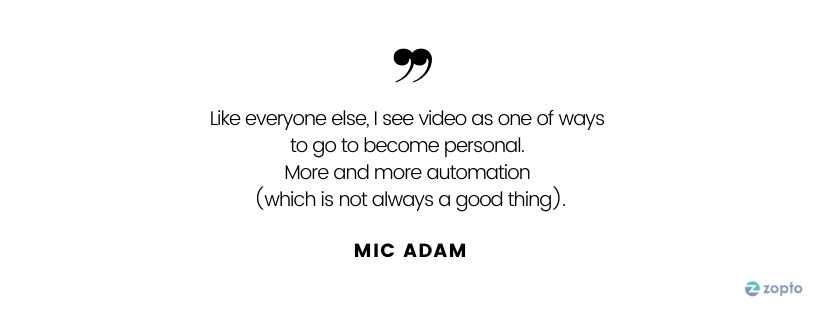
Tim Hughes
As one of the social selling pioneers, Tim Hughes provides his expert opinion about the future of the practice:
“Social selling has a very bright future – it’s going to change and evolve – some people are closing deals with Facebook and WhatsApp. Every day we need to be learning and experimenting. With social selling the prime selling time (PST) that we used to talk about no longer exists. There is certainly a blurring between work and play. Work life balance becomes even more important. Another challenge is that most people doing researches are socially native and can filter out noises easily – so sales people need to make sure they become a signal and not a noise. It’s important that they raise the level of their content and their profile to stand out and be recognized.”
Tim Hughes, CEO, DLA Ignite and author says that while organisations usually call on his expertise to help with prospecting, he often goes on to teach people how to use social selling throughout the whole sales process. “You can use social selling to develop leads, to move sales through the pipeline, and to close deals, and you do that by building relationships and by using content all the way through.“
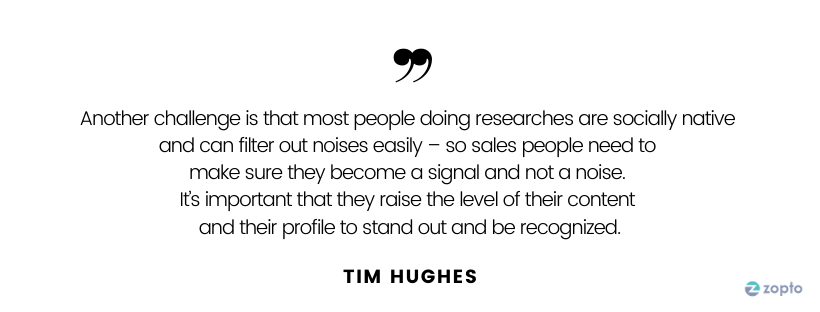
Tim Hughes, CEO, DLA Ignite and author runs a one day strategy session for board members. “It is a classic brainstorming session. We get them to come up with reasons why it won’t work, perceived barriers — for example, ‘Dave in IT doesn’t like cloud’ — and work with them to come up with a mission for that project.”
The approach to kickstarting a social selling strategy is no different to any other corporate strategy that requires board level agreement. Hughes adds, “Unless you get the board agreeing and senior stakeholders agreeing, the project will fail. It is a change programme and that is what a lot of people miss. It is a mindset change and a habit change, and you need board level members leading from the front — they need to be social.”
It is an oversight also made in traditional face-to-face selling, says Hughes. Companies too often use their sales team to front pitches instead of their technical experts. “Brands talk about their great technical capability for example, but why aren’t their technical team empowered on social? They are often the best people to talk because they are knowledgable and passionate. When a buyer researches a considered purchase they will look at the technical capability of an organisation and if that is externally exposed — the culture and beliefs — and communicated on social media, that will differentiate your company.
But make sure you understand and familiarise yourself with LinkedIn before you invest in Sales Navigator. Hughes likens it to driving a Formula 1 car. “I have been driving for over 20 years but if I got in a Formula 1 car I would crash it at the first corner because I don’t know how to drive it. We get lots of people coming to us saying can you train us on Sales Navigator and we say ‘yes, but you’re not social’. All it does is turn you into the world’s best spammer — people need to be social before they use Sales Navigator.”
Hughes adds that content can drive buyers throughout the purchase journey. “You can use social selling to develop leads, to move sales through the pipeline, and to close deals, and you do that by building relationships and by using content all the way through.”
Jack Kosakowski
Jack Kosakowski is another expert in the field of social selling. You can check out his appearance on the BeReal podcast discussing his thoughts on what the future could hold for this field.
Neil Schaffer
It is hard to imagine how sales was done before social media. How could you find out information about your prospect without asking them? Platforms like LinkedIn, for selling to organizations, and a combination of LinkedIn, Facebook, and Instagram, for selling to people, provide salespeople unparalleled access to what makes a person tick, who their friends are, who else is in their organization, etc. It is a treasure trove of information that will only increase as millennials and Gen Z, both generations of digital natives, become an overwhelming majority of buyers inside organizations as well as consumers. These generations use social media more than older generations and also share more about themselves in these networks, often using visual elements such as photos, videos, and even stories. Sales teams, therefore, should become proficient as to how to network as well as uncover business intelligence for not only today, but more importantly, for tomorrow.
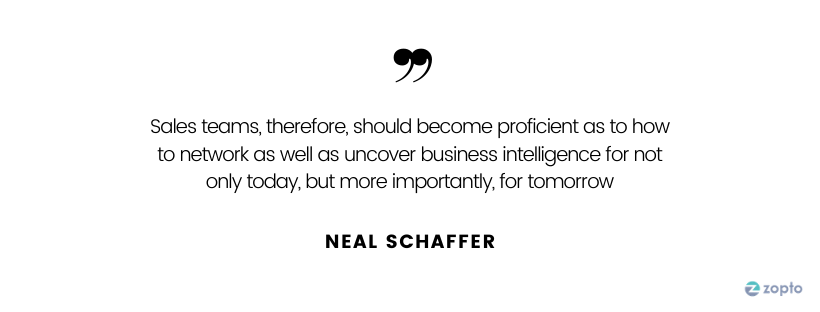
Brynne Tillman
Real sales is about solving, and we can only do that if we have real conversations with our buyers. And, the only way to get that call scheduled is to earn the right. A seller has to create a compelling reason for the buyer to invest her time in taking your call, and it is the perceived value that will get you that commitment. As a LinkedIn trainer, our only goal is to convert content and connections to conversations and that has to begin with creating curiosity, getting your buyer to think differently about their current situation, envision a desired future state, and the inkling, through thought leadership, that you might fill that gap between the two.
Theresa Merrill
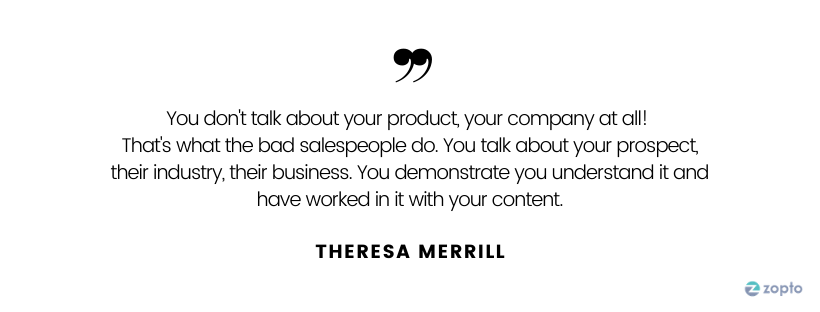
Social selling is still very relevant. The pandemic has made it even more so. Without the ability to see someone in person the sellers who were not previously using platforms like LinkedIn were at a huge disadvantage.
However, I’ve seen a surge in salespeople doing it wrong, too.
Social selling is not taking your antiquated sales pitch and moving it online. So if you weren’t necessarily good at selling before you likely will not be if you don’t change on social media platforms.
Social selling is building a powerful network of connections on LinkedIn and then nurturing and developing those through targeted content and messages that speak to their needs. It’s consistent, subtle and ultimately meant to be helpful.
Sharing the content needs to be done via messaging, not only by posting updates that may or may not be seen. And when you share it you need to link it to why it speaks to their challenge.
You don’t talk about your product, your company at all! That’s what the bad salespeople do. You talk about your prospect, their industry, their business. You demonstrate you understand it and have worked in it with your content.
If you do all that, the relationship will be developed and you will make all the other sellers look like they are product peddlers.”
Tom Martin
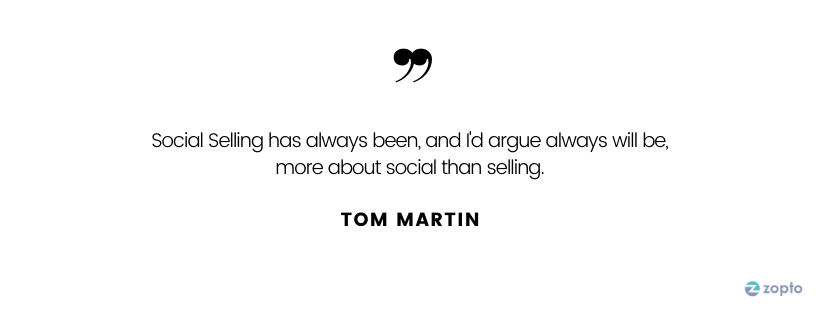
Social Selling has changed immensely over the last 10 years. In the early days, just the idea of selling via social platforms was laughed at, even ridiculed.
Fast forward to 2020 and everyone wants to talk about selling via social and digital platforms.
But while interest in social selling has grown, capabilities still lag. Too many sales teams are just cold calling with social platforms like LinkedIn vs a phone. And it isn’t working.
Social Selling has always been, and I’d argue always will be, more about social than selling.
Successful social selling practitioners must understand how to Sell Greatly by focusing on the 5 P’s of successful social selling – Proximity, Preparation, Presence, Patience and Preference.
By focusing on these 5 P’s and being relationship first in their approaches vs transaction first, they can truly harness the enormous power of social selling
Tom Martin
President
Converse Digital (www.conversedigital.com)
@TomMartin on Twitter
Bonus: Our Favorite Templates for Social Selling Success
If you’re now raring to get started with your own social selling, we’ve got a little bonus content for you. These tried and tested templates can get you started with your lead generation and outreach on a variety of different platforms.
This first template is a great introductory one that can be used for initial messages. It’s honest and to the point:
Dear [Their name], Your name came up on LinkedIn as someone I should connect with so I wanted to reach out and introduce myself. Let’s connect and explore ways we might be able to benefit one another’s network.
For something a little more personal and focused on content they’ve already shared or interacted with, try this one from Business2Community :
“Hi [their name]
I saw your most recent LinkedIn post on [topic]. I’m a [job title] at XYZ Company, and I shared that post with my colleagues. They were floored; there’s so much we could be doing to protect our company! I’d love to connect with you so I can follow more of your insights.
Hoping to hear from you,
[Your name]”
As you can see from both of these examples, building an immediate business connection. Although brief, they cover a motivation for you contacting them, and a mutual benefit for them accepting your connection request.
Instagram & Twitter
Things on these two platforms tend to be a bit more succinct than on others. However, you can still effectively get your point across and encourage engagement with your brand. Here’s a good example from Follows:
“Thanks for the follow! How are you doing? We’d love to make your day a bit better with this coupon to our store!”
It’s simple, easy to read, and offers immediate value to the person you’re sending it to.
Of course, there is scope to drop a longer message to your followers. As Elise Darma explores, something like the below can help with your outreach:
“Hi [their name]!
I love what you [create/do/say]. I especially love how you [mention specifics].
My name is [your name] and I’m an expert in [your field]. I help [target customer] achieve [their biggest pain point]. I couldn’t help but notice our businesses are aligned and I bet we’d get along great, too.
If you’d be interested in working together to trade our skills or services, I’d love to connect. I think your [service] would be a great FIT/SWAP with my [service]. If you’d like to discuss this idea more, let me know and we’ll find a time!”

